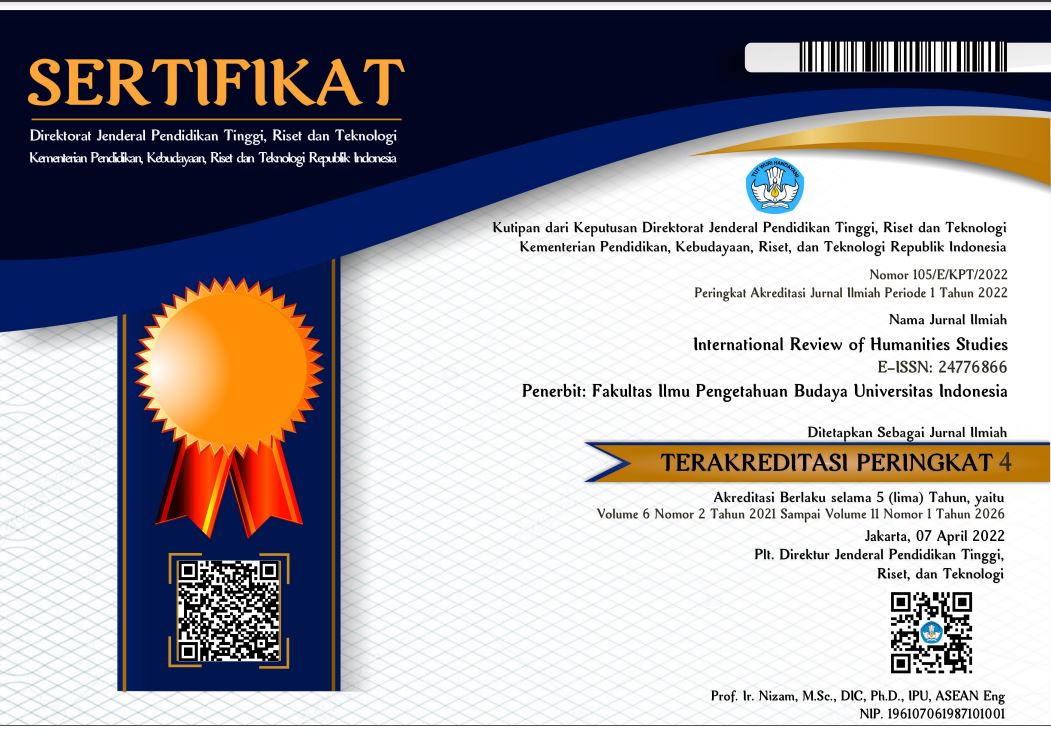International Review of Humanities Studies

Abstract
This article discusses the embodiment of the statues of the gods and goddesses at the Li Tie Guai Temple in West Jakarta. The embodiment of the statues in this temple is discussed using a life course perspective. The data used are all the statues of the gods in the temple, totaling thirty statues. The method used is study of literature and field data, followed by data processing which is done by classifying the statues into age, adult, teenager, and children as well as the shape of men, women, and others. The next stage is data interpretation. The results showed that there were more statues depicted in the forms of adults and old people compared to the forms of teenagers and children. This shows that from a life course perspective, a person during his or her lifetime becomes a god more when he or she is mature and old because the process of becoming a god requires special abilities and a purified soul that can be acquired over a long time. Then the embodiment of male statues is more numerous than the embodiment of female statues and others. This shows that in the past, especially in China, men had greater domination than women and others.
References
Blusse, L. (1988). Persekutuan Aneh Pemukim Cina, Wanita Peranakan dan Belanda di Batavia VOC. Pustazet Perkasa. BP3 Jawa Tengah. (2009). Dewa-Dewi Masa Klasik. Jawa Tengah: Balai Pelestarian Peninggalan Purbakala Jawa Tengah Depdiknas. (2000). Klenteng Kuno di DKI Jakarta dan Jawa Barat. Departemen Pendidikan Nasional. Elder, G. H. (1998). The Life Course as Developmental Theory. Child Development, Vol. 69(1), 1-12..DOI:https://doi.org/10.2307/1132065. Gilchirst, R. (2007). Archaeology and the Life Course: A Time and Age for Gender. In Meskel, L., & Preucel, R. W. A Companion to Social Archaeology. pp. 142-160. Blackwell Publishing. Herwiranto, M. (2007). Klenteng: Benteng Terakhir Dan Titik Awal Perkembangan Kebudayaan Tionghoa Di Indonesia. Jurnal Lingua Cultura, Vol 1(1), 78-86 . Hutchison, E. D. (2010). Dimension of Human Behavior: The Changing Life Course. Sage Publication. Junus, G. S. (2006). Tipologi Bangunan Klenteng Abad 16 Hingga Paruh Awal Abad 20 di DKI Jakarta. Universitas Indonesia. Lip, E. (1980). Chinese Temples and Deities. Times Books International. Purcell, V. (1980). The Chinese in Southeast Asia. Oxford University Press. Roberts, J. (2004). Chinese Mythology A to Z. Facts On File. Salmon, C., & Lombard, D. (2003). Klenteng-Klenteng Tua dan Masyarakat Tionghoa di Jakarta. Yayasan Cipta Karya Loka. Setiawan, E., & Hay, K. T. (1990). Dewa-Dewi Kelenteng. Yayasan Kelenteng Sampookong. Sharer, R. J., & Ashmore, W. (2003). Archaeology, Discovering Our Past. McGraw-Hill.
Recommended Citation
Zaqi, Muhammad and Marwoto, Irmawati
(2023)
"MANIFESTATION OF THE STATUES OF DEITIES IN THE LI TIE GUAI TEMPLE IN WEST JAKARTA: A LIFE COURSE PERSPECTIVE,"
International Review of Humanities Studies: Vol. 8:
No.
2, Article 6.
DOI: 10.7454/irhs.v8i2.112
Available at:
https://scholarhub.ui.ac.id/irhs/vol8/iss2/6


